Oak Hill Country Club's 11 greatest shots and moments in major championships
Every major event that has been played at Oak Hill Country Club has its own story, its own ebb and flow, and ultimately its own champion because no player has ever won twice on the East Course.
They also have had their own unique combination of feats of greatness, dramatic moments, and unforgettable shots produced by a lineage of players who are among the greatest in the history of the sport.
Oak Hill will be on the golf world’s main stage for the 13th time when the 2023 PGA Championship gets underway May 18, and over the course of four days, there are sure to be several more additions to the long list of memories that have been forged at one of America’s truly iconic venues.
I have certainly been fortunate in that this will be the eighth Oak Hill major event I have covered for the Democrat and Chronicle, dating back to the 1989 U.S. Open. Through my own in-person observations, and my research of the five events that were contested at Oak Hill before I arrived in Rochester, I have compiled a list of one great shot and/or pivotal moment for each.
More: Oak Hill will look different for pros playing in 2023 PGA championship
More: PGA Championship expected to bring nearly $200M to Rochester
1949 U.S. Amateur
Johnny Dawson, 2-foot bogey putt, 3rd hole, quarterfinal match
Sometimes you need to hit a great shot at a key time to win a golf tournament, and other times, the break you need comes when your opponent makes a critical mistake. The latter was the case for Charlie Coe in the first major event held at Oak Hill.
Coe played almost flawless golf on the final two days, rolling to an 8-and-7 victory over Bill Campbell in the semifinals, and then eviscerating Rufus King 11-and-10 in the 36-hole championship match, still the second-largest margin of victory in the 117-year history of the tournament.
However, Coe wouldn’t have even reached that point if not for two blunders by his quarterfinal opponent, Dawson, his friend and former Walker Cup teammate. After rallying from a 2-down deficit to tie the match, Dawson had a chance to win at the 18th hole, but he three-putted from 60 feet for bogey to spare Coe.
And then on the third extra hole, the 201-yard par-3 third, both players missed the green and hit poor second shots onto the green. Coe lagged to within inches and was conceded a bogey, and then Dawson left his par attempt two feet short, but there was no concession from Coe. He made Dawson putt, and Dawson’s ball hit the lip of the cup and stayed out, giving the match to Coe.
“That’s what kind of started the tournament for me,” Coe said, recalling that match, plus his morning round of 16 match when he rallied from 3-down with five to play to defeat Harvie Ward. “I don’t remember the first two or three matches, but I remember that day.”
1956 U.S. Open
Cary Middlecoff, 4-foot birdie putt, 18th hole, final round
The shot that is most remembered from this tournament is Ben Hogan’s shocking miss of a 30-inch putt at No. 17 in the final round which cost him a realistic chance of winning a record fifth U.S. Open.
However, the shot that should be remembered most was Middlecoff’s slippery, downhill, sliding four-footer that saved par at the 72nd hole and wound up being the difference in his one-stroke victory over Hogan.
“I would say that was the greatest accomplishment I ever had on one particular, very important shot,” said Middlecoff, who counted the 1949 and ‘56 U.S. opens, and the 1955 Masters among his 40 PGA Tour victories. “That was the big shot of the tournament for me. I knew I was going to win if I could make it. I almost fell dead at the last three holes. I made five on 16 and five on 17. That apple jumped up in my throat and almost choked me.”
1968 U.S. Open
Lee Trevino, 35-foot birdie putt, 11th hole, final round
One thing that marked Trevino’s breakthrough victory on the PGA Tour was the merry way the man who would later become known as the Merry Mex bantered his way around Oak Hill, seemingly oblivious to the pressure of trying to win the U.S. Open.
However, his demeanor changed when he made the turn in the final round, realizing that he was nine holes away from a career-altering triumph. After a solid par at the 10th hole, Trevino stepped to the tee at the par-3 11th and hit a mundane 6-iron left of the hole. Par seemed likely, but he stroked a beautiful putt across the green that dropped in for a clutch birdie.
“All I wanted to do was par in from there, get as big a lead as I could so I wouldn’t choke it off,” Trevino said. He followed with a birdie at the 12th, then held on down the stretch to out-distance Jack Nicklaus by four shots.
1980 PGA Championship
Terry Diehl, bunker shot, 4th hole, final round
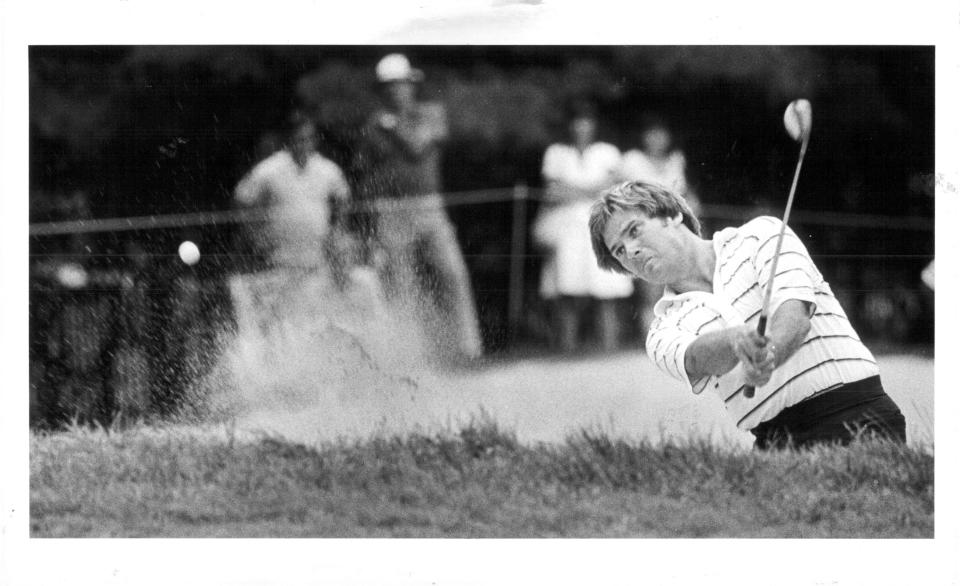
The Rochester native was trying to write the ultimate Hollywood script, winning a major championship on his home course, though trailing eventual champion Jack Nicklaus by seven shots entering the final round made that virtually impossible.
More realistically, Diehl, the winner of one Tour event, was aiming for a top-8 finish which would have guaranteed him a coveted exemption into the following year’s Masters and U.S. Open. “I thought I was going to contend; there wasn’t any doubt in my mind,” he said.
A birdie at the third hole had his spirits soaring, but in a matter of moments, it all exploded for Diehl. He hit his tee shot on the par-five fourth into the bunker along the right side of the fairway, and then the golf gods really bit him.
He topped his shot from the sand just a tad and the ball caught the lip of the trap, caromed dead right, bounced off a spectator, and came to rest about two inches out of bounds. That mishap led to a triple-bogey 7 and in the end, Diehl finished tied for 10th, missing out on the top-8 by two strokes.
“Curtis Strange told me it was the worst break he’d ever seen,” said Diehl.
1984 U.S. Senior Open
Miller Barber, 2-iron approach, 17th hole, final round
Arnie’s Army was in full throat, trying to root the king on to victory, but Arnold Palmer’s charge to overtake Barber took a big hit. He made a shocking double-bogey at the 15th hole, the result of him carelessly stubbing his putter on a tap-in and rightfully counting that as a stroke even though no one even realized what he’d done.
Naturally, Palmer didn’t quit. He birdied No. 16 to get back within two shots of Barber, saying, “If you’re stupid enough to (whiff) you should be smart enough to forget it.” And then he watched Barber push his tee shot at 17 into the right rough and suddenly there was hope.
But with the door ajar and Palmer ready to burst through, Barber hit a marvelous 2-iron from a difficult position and his ball stopped just short of the green. From there Barber made a rather routine up-and-down par to slam the door closed.
“(It was) one of the best shots of my life,” Barber said.
1989 U.S. Open
Four tee shots, 6th hole, second round
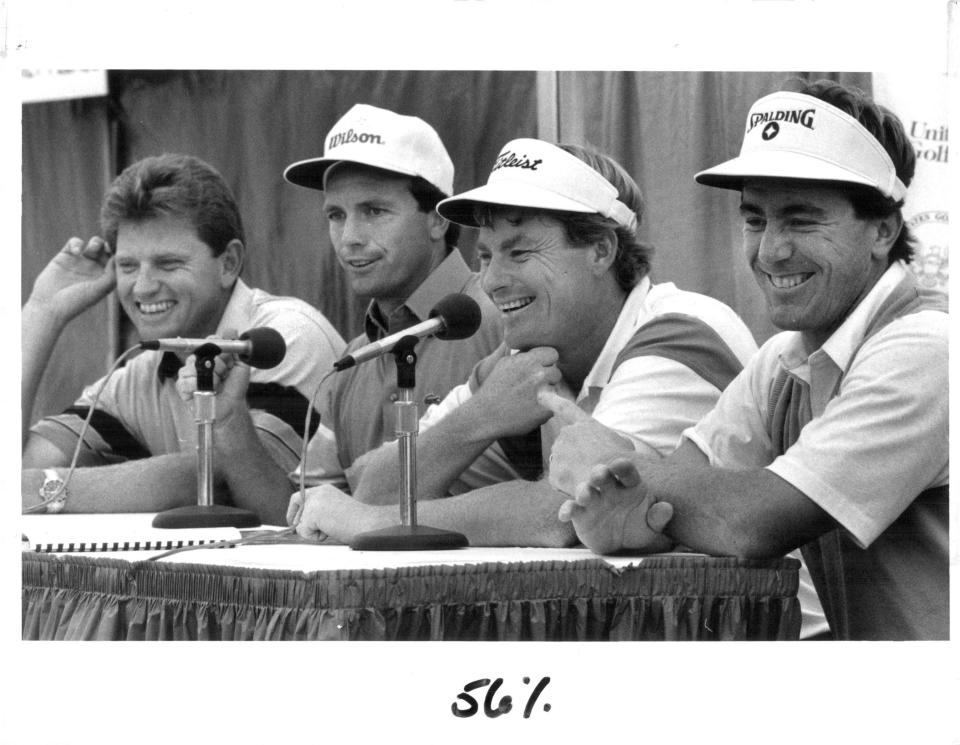
There were several key shots hit by winner Curtis Strange, but what happened in a span of two hours during the morning of the second round at the now extinct par-3, 167-yard sixth hole was historic.
Four players – Doug Weaver, Mark Wiebe, Jerry Pate and Nick Price – all used 7-irons to make a hole-in-one, a feat that very likely will never come close to being duplicated, not in a major championship, nor anywhere.
That day, the cup was cut in a spot between two subtle mounds where the ball seemed to funnel right to the hole. There were also 28 birdies made by the field of 156 players, and No. 6 was the only hole that played cumulative under par for the day at 2.98 strokes.
Fred Funk, who came through shortly after the last ace and made a birdie, turned to the gallery and said, “I can’t believe you’re clapping for a two.”
1995 Ryder Cup
Corey Pavin, chip in, 18th hole, second-day best-ball match
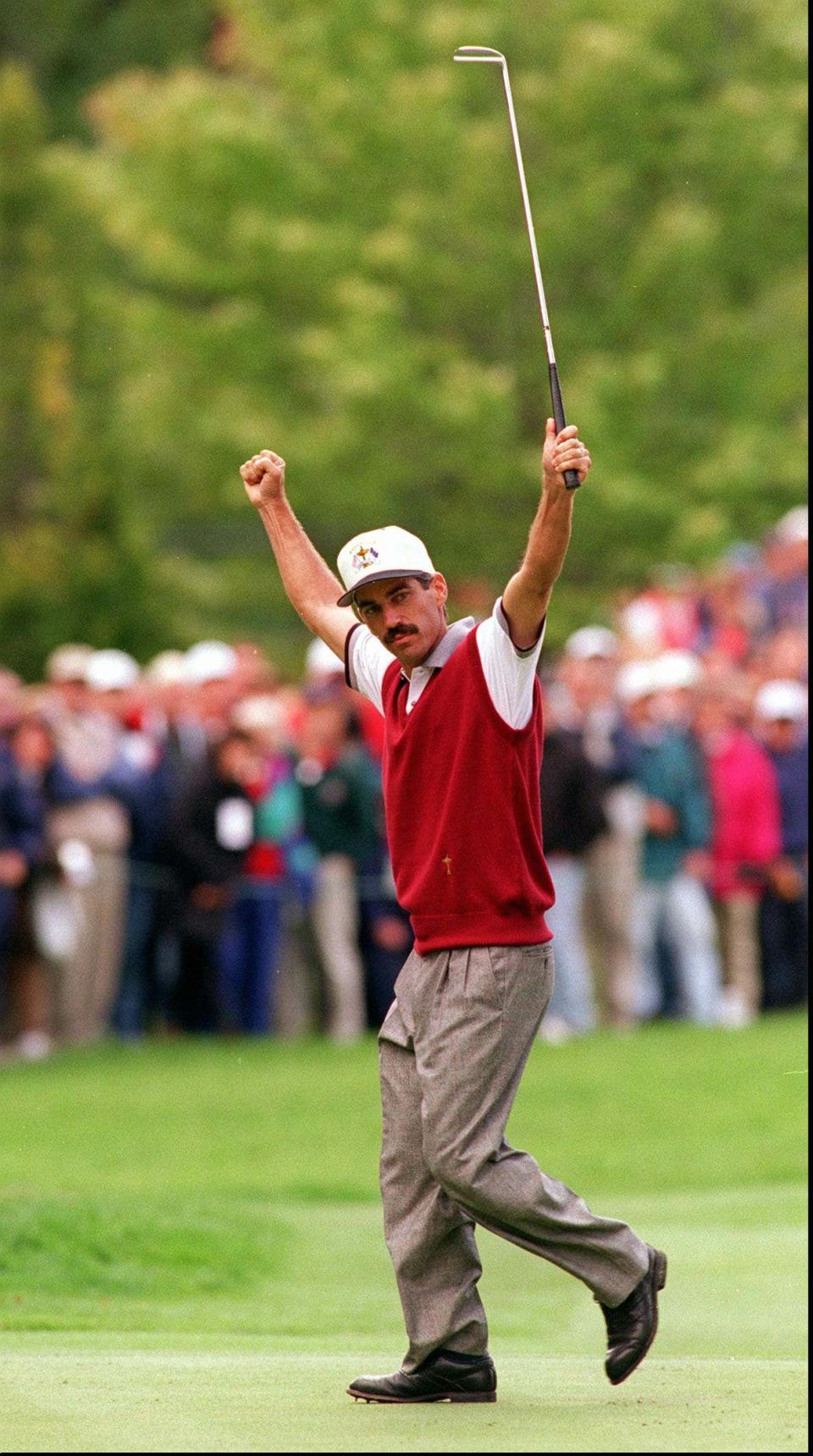
Of the seven events I have covered, this is the shot that has resonated most for me. That entire week was different than any other at Oak Hill because it was the Ryder Cup, my favorite golf competition, one that stirs emotions and fervor similar to soccer’s World Cup and the World Baseball Classic.
And at that time, the Ryder Cup was at the zenith of its popularity on both sides of the ocean. When Pavin chipped in for birdie to secure he and partner Loren Roberts’ best-ball victory over Nick Faldo and Bernard Langer, the ground literally shook. I’ve never heard a roar quite like that, and it gave the Americans what seemed like an insurmountable 10-6 lead heading into the Sunday singles.
Of course, it turned out it wasn’t insurmountable at all as the Europeans rallied in dramatic fashion to win the cup for the first time since 1989.
1998 U.S. Amateur
Hank Kuehne, 6-foot par putt, 16th hole, championship match
With Tom McKnight on the comeback trail in the 36-hole championship match, having won the 32nd and 33rd holes and already safely in with a par at the 34th, the pressure was squarely on the shoulders of Kuehne.
Kuehne’s 3-up lead had been reduced to 1-up, and if he didn’t make the tricky left-to-right six-footer on the 16th green, the match would be all square with two holes to go.
Trip Kuehne, Hank’s brother who was caddying for him, took one look at the putt and his knees started quivering as much as Hank’s because he knew it was a delicate shot that needed to be struck perfectly. “(Hank) said ‘left edge?’” Trip recalled. “I said, ‘I love it, step up, be a man and knock it in.’ And he did it. That putt was as good as it gets.”
A pumped-up Kuehne moved to the 17th tee, ripped a 311-yard drive down the middle, wound up making a routine par, and McKnight’s bogey ended the match with Kuehne a 2-and-1 victor.
2003 PGA Championship
Shaun Micheel, 7-iron, 18th hole, final round
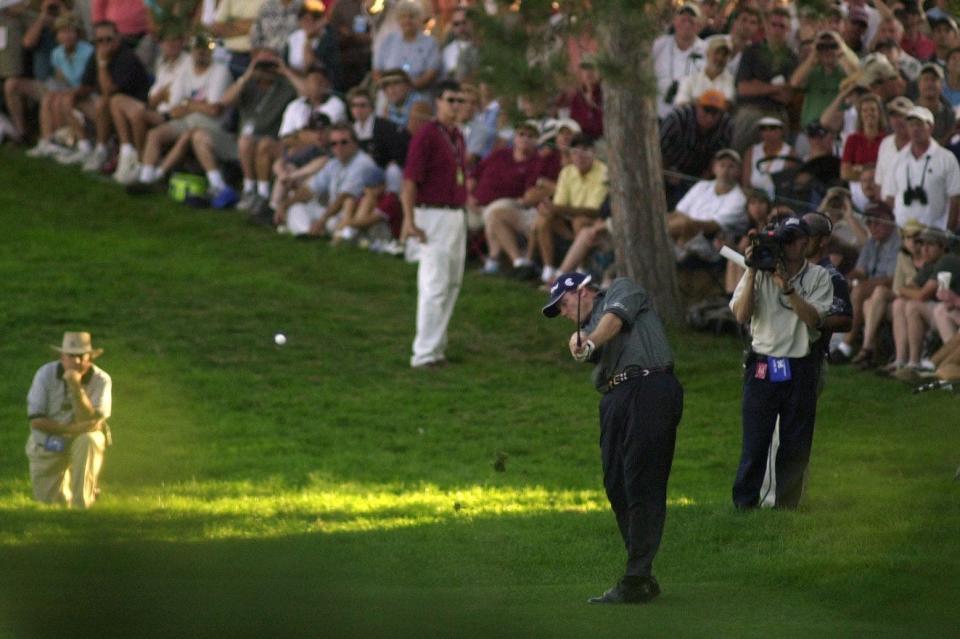
When Micheel reached the green at the 18th hole, greeted by a raucous ovation from the overflow gallery, he couldn’t quite believe what he saw. And neither could his playing partner and closest pursuer, Chad Campbell.
“That would probably be the best shot I’ve seen under pressure,” Campbell said of Micheel’s 174-yard 7-iron approach that stopped two inches from the hole, locking up Micheel’s highly unlikely victory.
“When that ball was in the air, all I was asking for was just to carry to the front of the green,” said Micheel. Instead, it landed just below the pin and nestled in so close that it became the easiest gimme one could imagine to secure a major championship.
2008 Senior PGA
Jay Haas, 8-iron, 17th hole, third round
Haas was drafting just behind co-leaders Jeff Sluman and Bernard Langer as the third round was coming to a close. After a sluggish start, Haas had jumped back into contention with some solid play over the previous few holes, but he took it to another level on the 458-yard par-4 17th.
His drive, which he called “probably one of the best drives of the week,” was too good. It skipped into the rough off the left side of the fairway, and not only did he have the long grass to contend with, he had a tree limb that he needed to stay underneath.
“I had 162 to the hole, 157 to the front, which didn’t really matter a whole lot because I had to go under a limb and I was just trying to rake it up there somewhere in the gap,” Haas said.
Well, he did a little better than that. He struck the ball perfectly, and by the time its journey was complete, it was sitting in the bottom of the cup for a magnificent eagle. “I thought, ‘Well this might be close,’ and by that time it disappeared,” he said. “So, I saw the crowd go nuts up there and I went pretty nuts.”
That shot sent him on his way as he shot 74 on Sunday to edge Langer by a stroke.
2013 PGA Championship
Jason Dufner, 12-foot birdie putt, 18th hole, second round
The surprise champion hit several terrific shots on his way to breaking Nicklaus’ all-time 72-hole East Course scoring record with a 10-under-par total of 270, but the most memorable shot of his week was one he’d like to forget.
Dufner left short his birdie attempt at 18 on Friday which prevented him from becoming the first player in history to shoot 62 in a major championship.
“It’s tough when you’re chasing history,” said Dufner, who tapped in from a foot away in front of the huge gallery to close out his 7-under-par 63 which vaulted him into the lead at the midway point. “I don’t think I’ve been the first to do anything in my life. Pretty nerve-wracking. I wish I had that putt on the last hole back again.”
Dufner settled for the new competitive East Course record, erasing the matching 64s of Ben Hogan and Curtis Strange from the record book. He became the 24th man to shoot a 63 in a major, and the 12th to do it in a PGA, and he knew as he studied that putt at No. 18 exactly what was on the line.
“I know the history of major championships, so I knew that nobody had shot 62, and the course record I had heard on TV earlier in the week,” said Dufner. “So I knew where I stood and you couldn’t have a better chance at history on the last hole.”
2019 Senior PGA
Ken Tanigawa, 10-foot par putt, 18th hole, final round
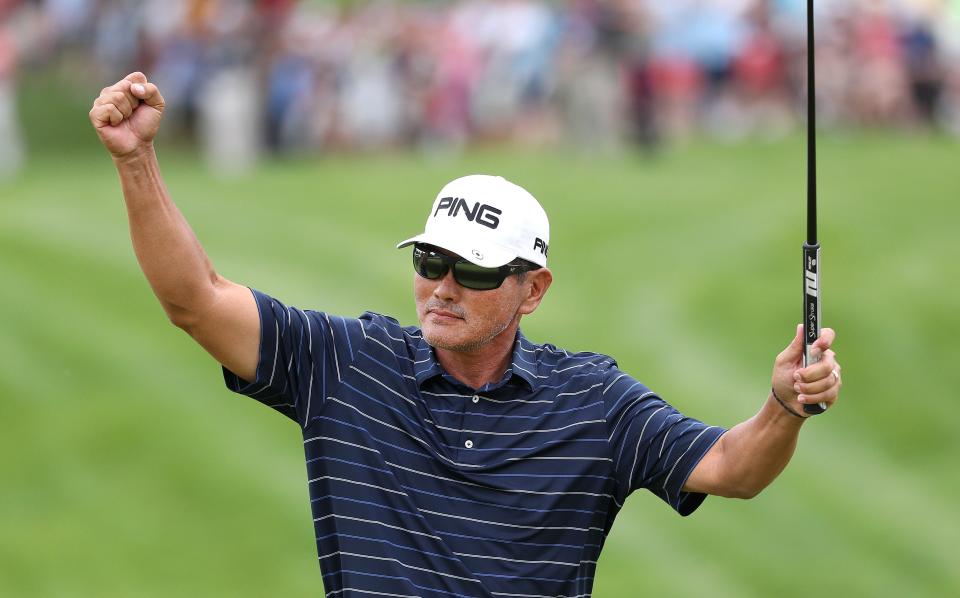
The unlikely champion had moved into the lead at the 16th hole when he made a birdie and defending champion Paul Broadhurst made a double bogey. But after a bogey at 17, and a poor tee shot into the bunker on the right side at 18, Tanigawa said he was “leaking oil.”
Tanigawa could only play his bunker shot back to the fairway and then try ot get up and down for par. His gap wedge third shot landed in the rough behind the green, but it slid back onto the green and stopped 10 feet from the hole.
“I would love to say yes, but I’m going to be honest, I tugged it a hair,” he said when asked if that’s how ge planned the shot. “I knew I just couldn’t come up short. I hit it solid, so I knew if it got back there it would spin back and, yeah, I guess it could have gone and one-hopped in the rough, but thank goodness it didn’t.”
Tanigawa then drained the putt and watched as his playing partner and former UCLA teammate, Scott McCarron, and Broadhurst failed to make up the stroke they needed to tie him.
Sal Maiorana can be reached at maiorana@gannett.com. Follow him on Twitter @salmaiorana.To subscribe to Sal's newsletter, Bills Blast, which will come out every Friday during the offseason, please follow this link: https://profile.democratandchronicle.com/newsletters/bills-blast
This article originally appeared on Rochester Democrat and Chronicle: Oak Hill Country Club's best shots and moments in major championships

